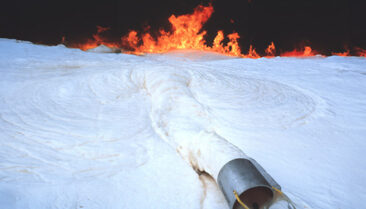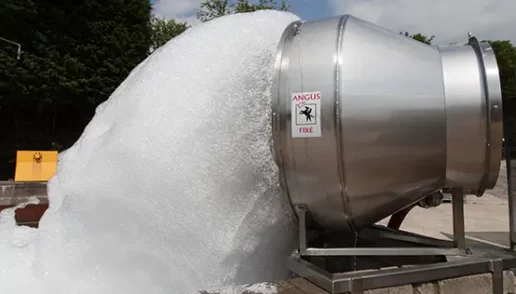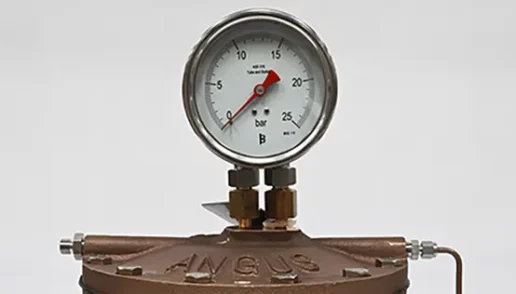Chubb offers a range of aqueous (foam) fire suppression systems and products to suit a variety of commercial and industrial applications. Our aqueous systems are engineered to quickly suppress fires and protect your critical assets.
Aqueous suppression systems are suitable for both Class A and Class B fires occurring in multiple environments like refineries, power plants, data centres, turbines, generator facilities and flammable liquid storage spaces. See our range of systems and equipment below.
Chubb offers a range of Angus Fire foam and fixed foam equipment to suit a variety of commercial and industrial applications. These include foam concentrates, top pourers, rimseal generators and pourers, mex bund pourers, high expansion foam generators and proportioning devices.


Foam top pourers
Angus Fire has been protecting tanks using top pourer technology for over 30 years. Constant research and development has lead to the current designs which meet the demands of modern day tank protection including the need for full surface pourers.
Angus top pourers are used to protect fixed roof tanks, storing both hydrocarbon and polar solvent fuels.
Angus Fire foam top pourer sets, TPS Mk 4 and TPS Mk5 are designed for use in foam systems for the protection of flammable liquid storage tanks with nitrogen inerted blankets and/or tank internal pressures below 5 psig and combine foam generation, vapour sealing and foam pouring in a robust, low-maintenance integral unit.
Modern materials such as graphite and stainless steel are employed to ensure each unit performs to the precise pressure and flow standards laid down by Underwriters Laboratories (UL) and NFPA.
There are four basic body sizes with capacities ranging from 75 to 3,300 lpm at inlet pressures between 3 and 10 barg. Each unit is factory calibrated to perform at a fixed flow and pressure point within the limits shown overleaf. The system designer is therefore able to make the most cost-effective use of available water and foam concentrate resources.
The discharge characteristics of the TPS Mk 4 and TPS Mk5 are enhanced by the deflector plate fitted to the outlet which disperses the finished foam against the tank wall. This ensures a more rapid spread across the surface of the fuel, whilst lowering the application velocity to reduce contamination of the foam by the fuel, an important consideration especially on polar solvent fuels.
Inspection, routine maintenance and replacement of the frangible glass disc are facilitated by an easily removed cover on top of the unit. Special heavy duty glass discs are fitted which are suitable for internal tank pressures up to 5 psig.
Angus Fixed Foam Equipment Brochure
Angus Fire Tank Protection Brochure
Angus Fire Top Pourer Brochure


Rimseal protection
Floating roof tanks are widely used to store large quantities of petroleum products. They are fitted with a floating roof that rises and falls as the liquid level in the tank changes. 90% of the fires in open floating roof tanks start in the seal area between the floating roof and the tank wall, known as rimseal.
Angus Rimseal Pourers are designed to apply foam into the rimseal in the event of a fire.
The Angus Rimseal unit comprises two elements – the Rimseal Foam Generator which produces expanded foam when supplied with foam solution, and the Rimseal Foam Pourer which delivers the foam gently into the rimseal area.
The RFP is a low-profile unit which protects the foam from high winds and guides it gently on to the tank wall. The front shield allows fully developed foam to emerge in a cohesive blanket that flows intact onto the inside wall of the tank. The stainless steel mesh at the foam exit helps to prevent blockage from insects and nesting birds.
Angus also offer the option of one-piece units (RFP50F and RFP80F) incorporating a flange on the end of the foam inlet pipe. An orifice plate is supplied, which calibrates the flow rate of the unit. The orifice disc is fitted between the flange on the RFP50F and RFP80F, and the corresponding flange on the supply pipe. The RFP50F and RFP80F produce expanded foam when supplied with foam solution and delivers the foam gently into the rimseal area.
For new tanks, the Angus Rimseal Pourers make the most cost-effective use of foam concentrate and water resources by producing the designed foam solution application rate.
For retrofit onto existing tanks during refurbishment, the Angus RFG, RFP50F and RFP80F models can replace existing units without the need for expensive modification. Accurate factory-calibration ensures full compatibility with existing foam concentrate induction systems.
To further simplify installation, a fixing kit is now supplied as an optional extra which facilitates installation to the tank whilst still in use and without the need for hot work.
Angus Fire Rimseal Foam Equipment Brochure


Mex (medium expansion) bund pourers
Bund fires are often caused by leaking flanges or valves at the base of tanks, damaged or cracked pipe work, and sometimes because of spills as a result of maintenance work.
For a long time fixed foam systems have been used to protect fuel storage tanks, but traditionally firefighters have relied on portable branchpipes or monitors to protect the bunded containment areas surrounding the tanks.
Both portable branchpipes and monitors have distinct disadvantages for protecting this risk. In the case of portable branchpipes firefighters may have to enter the bund to apply foam to the fire thereby putting themselves at risk. Monitors are designed to project a stream of foam long distances at high velocity e.g. tank roofs or jetty protection. In the case of bund protection their application can be too forceful, plunging the foam into the burning fuel causing fuel/foam mixing, or splashing the fire over into other areas. They have the added disadvantage of applying low expansion foam – which can be slow to cover large areas to a sufficient depth compared with a medium expansion foam blanket.


High expansion foam systems
High expansion foam systems represent the most effective protection for such specialised and severe cryogenic risks as LNG (Liquified Natural Gas) and LPG (Liquified Petroleum Gases). Angus Fire’s LNG Fixed Turbex Systems meet the extremely demanding performance requirements for this high risk application.
Engineered to the highest standards for exceptional reliability and minimal maintenance, the FT1- 500P/LNG and FT2-500P/LNG Fixed Turbex Systems feature a foam making net and fan, which benefit from a special boiler grade of stainless steel designed to withstand continuous high temperatures without a reduction in material strength or risk of intergranular corrosion. The complex structure of the foam making net is specially supported to avoid distortion and the tubular support frame has holes drilled to prevent moisture build-up and relieve air expansion when heated. Special glass rope lagging insulates the water turbine and three lifting lugs are provided to assist with site installation. Rugged construction and careful choice of materials provides exceptional corrosion resistance against highly saline, humid and high temperature environments.
The high efficiency design of the Angus LNG Fixed Turbex System has enabled these units to exceed the severe requirements of the National Fire Protection Association NFPA 11A Fire Exposure Test. Performance is unaffected even after exposure to temperatures up to 1000°C during the 5 minute pre-burn period of this test.
Turbex LNG Skids are the proven high expansion foam systems solution to provide a fast and effective answer for LNG (Liquefied Natural Gas) spills in contained areas, whether vapourising or on fire.
Turbex LNG skids provide all the specialist features needed for LNG including a specially engineered skid base, LNG Turbex high expansion foam generator, plus discharge hood designed to protect the Expandol foam from wind and direct it downwards into the pit of LNG. Each LNG Turbex Skid is engineered from high performance 316 stainless steel and gunmetal materials.


Proportioning equipment
Common to all fixed foam fire fighting systems is the need for a suitable induction/proportioning system to mix a pre-determined amount of foam concentrate with the fire mains water to produce a foam solution. The foam solution is then supplied through the fire system pipework to a finished foam generator or other delivery device.
The selection of the correct proportioning system is of paramount importance to ensure foam is delivered at the required application rate to extinguish the fire.
In most cases a foam induction/proportioning system will consist of one of the following types:
Where the foam solution demand is constant:
Where variable foam solution demand over a wide range may exist:
Constant flow systems are where the demand of the foam generator or delivery device for foam solution is constant, either because they are protecting a single risk or because all systems will operate simultaneously.
Variable flow systems include those where the demand of the delivery devices for foam solution varies over a significant range. These systems are ideal for more complex multi hazard systems were some but not all of the foam delivery devices or systems are on, and the number may vary. At the same time these variable flow systems must retain the capacity for all systems and devices to be activated at the same time if required. Examples of a variable flow system might be a zoned sprinkler system in a process area where just 1 zone, 2, 3 or all 4 zones may be required to operate at any time.
Angus Fire Fixed Inline Inductor Data Sheet
Angus Fire Balanced Pressure Foam Proportioner Data Sheet
Angus Fire Balance Valves Data Sheet
Water based fixed fire suppression systems are installed to protect life/building or high risks high value assets. Due to the high risk of loss of life or building, these systems are often recommended by insurers.


Foam/Water Sprinklers
Angus Foam/Water, open, air aspirating, nozzles designed for use as part of an engineered fire protection system.
Each sprinkler is designed for mounting in the pendant position and produces a solid cone discharge with very similar spray patterns for both foam and water. The fire protection system can therefore be designed in accordance with NFPA 11/16, to deliver an initial foam discharge to combat a flammable liquid fire, followed by a period of water discharge to provide additional cooling if required.
Angus K40 & K20 Foam/Water Sprinkler Data Sheet
Contact Chubb for
more information
about the products